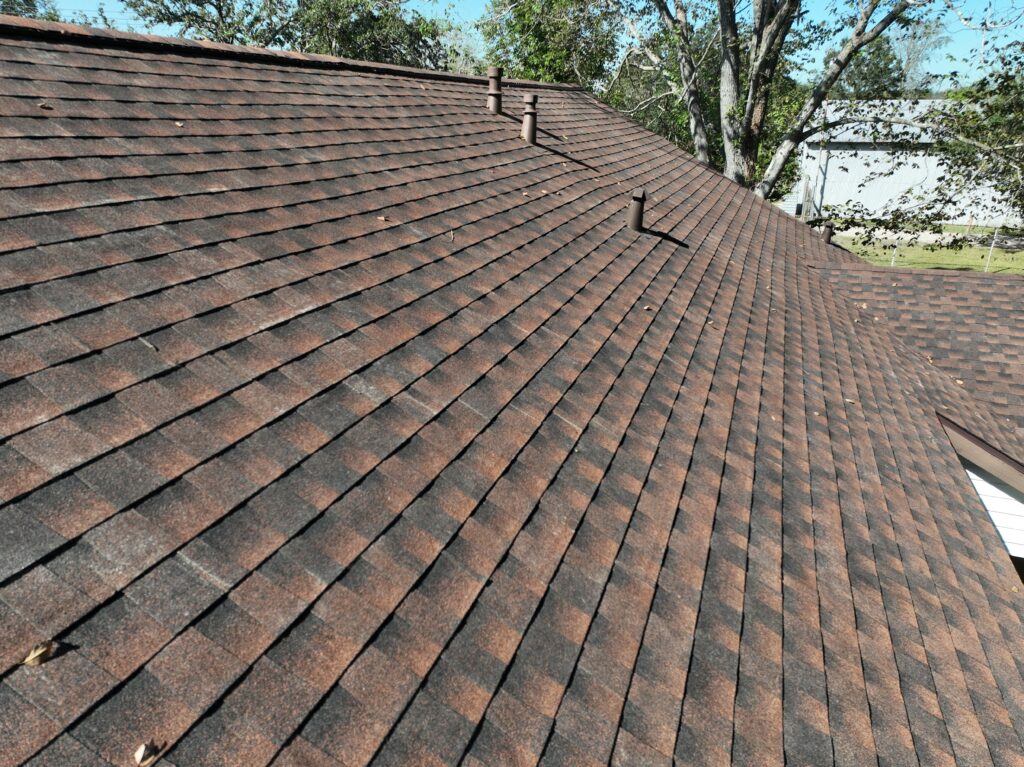How Long Does it Take to Replace a Roof?

*Updated August 13th, 2025
If you’re planning a roof replacement, you probably have a lot of questions and concerns—one of the bIf you’re planning a roof replacement, you probably have a lot of questions and concerns—one of the biggest being, “how long does it take to replace a roof?” The answer isn’t always straightforward because several factors can influence the roof replacement timeline. The size of your roof, the type of roofing material you choose, and even the weather can all play a role in how quickly the new roof is installed.
Replacing a roof is a significant project, but knowing what to expect can make it feel much more manageable. Understanding the timeline of a roof replacement helps you prepare for possible delays, plan around the work, and set your budget accordingly.
In this guide, we’ll cover the key factors that affect how long a roof replacement will take and share practical tips to help keep your project on schedule. By the end, you’ll have the information you need to approach your roof replacement project with confidence and peace of mind. Let’s get started!
Table of Contents
- Factors That Affect How Long It Takes to Replace a Roof
- Typical Roof Replacement Timeline
- Tips to Ensure a Smooth and Timely Roof Replacement
Factors That Affect How Long It Takes to Replace a Roof
Whether you’re upgrading to durable materials or dealing with unexpected repairs, understanding what affects the roof replacement timeline can help you prepare. From the size of your roof to the weather forecast, here’s what you need to know before scheduling your roof installation.
1. Roof Size and Complexity
The size of your roof and the complexity of the roof design play a significant role in determining how long it will take. Both factors directly impact the amount of labor, materials, and precision required to complete the roof replacement process.
How Roof Size Affects the Timeline
Larger roofs require more materials, labor, and time to replace. Here’s a general breakdown:
- Smaller Roofs (around 1,500 sq. ft.): Typically take 3–5 days to complete.
- Larger Roofs (3,000 sq. ft. or more): Can take a week or longer, depending on weather conditions and crew size.
The larger the roof, the more workers and resources are needed to stay on schedule.
The Impact of Complex Roof Designs
Certain roof designs require extra time and care to replace due to their features and structure:
- Dormers, Chimneys, and Skylights: Precision work around edges and flashing adds to the timeline.
- Steep Slopes and Pitches: Roofs with steep angles require additional safety equipment, slowing progress.
- Multiple Angles and Ridges: Complex shapes need precise cutting and fitting of roofing materials, adding more time.
In general, a simple, flat roof will take far less time to replace than a complex roof with numerous features. Proper planning and professional roofing labor are crucial for maintaining timelines on complex projects.
2. Type of Roofing Material
The roofing material you choose isn’t just about style—it also affects how long a roof replacement will take. Different materials have varying levels of complexity and require specialized skills or tools.
Asphalt Shingles
- Installation Time: 1–3 days
- Why It’s Faster: Asphalt shingles are the most common roofing material, lightweight, and easy to handle, making efficient roof installation possible.
- Installation Time: 3–5 days
- Factors Affecting Time: Requires precise techniques and custom cuts. Slower than asphalt but offers long-term durability.
Slate or Tile Roofing
- Installation Time: 6–10 days
- Challenges: Heavy and fragile, requiring careful handling and specialized labor.
Flat Roofs
- Installation Time: 2–5 days
- Why It’s Unique: Materials like TPO or EPDM involve heat-welding seams or adhering membranes, requiring precision during roof installation.
Understanding your type of roofing material helps you plan for installation time and manage expectations for your roof replacement project.
3. Weather Conditions
Weather can greatly affect the timeline of a roof replacement.
- Rain or Snow: Wet or icy conditions can halt work and delay material adhesion.
- Extreme Heat or Cold: High temperatures make working on the roof dangerous; cold can make adhesives brittle.
- Plan for Ideal Weather: Spring and early autumn are generally the best seasons for roof installation.
4. Contractor Availability and Crew Size
The roofer you hire and the size of their crew can dramatically affect how long it takes to replace a roof.
- Experienced Contractors: Bring efficiency, minimize mistakes, and keep the project on schedule.
- Crew Size: Larger crews can work simultaneously on tear-off and roof installation, reducing overall time. Smaller crews may add days.
Scheduling during peak seasons like spring and fall can affect availability. Booking a reputable roofing contractor in advance ensures your roof replacement timeline stays on track.
5. Existing Roof Condition
The condition of your old roof also plays a role in how long it takes to complete the replacement.
- Tear-Off Challenges: Multiple layers or damaged shingles increase removal time.
- Hidden Issues: Water damage, rot, or pest infestations may require additional repairs.
- Structural Reinforcements: Heavy materials like tile or slate may require extra support.
Additional Factors
Permits and Inspections: Securing permits and scheduling inspections can add to the time if not handled in advance.
Access Challenges: Narrow streets, small yards, or limited roof accessibility can slow progress.
Customizations: Features like skylights or solar panels require extra steps during roof installation.
Typical Roof Replacement Timeline
Most standard roof replacements take 3–7 days. Here’s a stage-by-stage look at time it takes to complete a roof replacement:
- Inspection and Planning (1–2 Weeks)
- Roof Inspection: Evaluate damage and structural integrity.
- Estimates & Contracts: Confirm plans and order materials.
- Material Delivery: Specialty materials may take longer.
- Prepping Your Property (1 Day)
- Site Protection and Safety Setup
- Removing the Old Roof (1–2 Days)
- Tear-off old shingles and underlayment
- Roof Deck Inspection and Repairs (1 Day)
- Repair damaged decking if necessary
- Installing the New Roof (1–3 Days)
- Asphalt Shingles: 1–2 days
- Metal Panels: 3–5 days
- Tile or Slate: 5–7 days
- Final Inspection and Cleanup (1 Day)
Total Roof Replacement Timeline: 3–7 days for standard homes, longer for larger or more complex roof designs.
Tips to Ensure a Smooth and Timely Roof Replacement
- Schedule During Favorable Weather: Spring or early autumn is ideal.
- Choose an Experienced Contractor: Look for professional roofing expertise and crew size.
- Prepare Your Property in Advance: Move vehicles, secure furniture, and protect valuables.
- Plan for Unexpected Delays: Weather or hidden roof damage can take longer to replace.
Conclusion
Every roof replacement project is unique. Standard homes usually take 3–7 days, but larger or complex roofs may require more time. Choosing an experienced roofer, scheduling during optimal weather, and addressing potential issues in advance can make the process smoother.
Thinking about replacing your roof? Contact a professional roofing contractor to get a personalized estimate and a roof replacement timeline tailored to your home.
FAQs
How long does it take to remove and replace a roof?
Typically 3–7 days, depending on roof size, type of roofing material, and weather.
What is the best month to replace a roof?
Spring or early autumn for mild temperatures and lower chances of rain.
Should I stay home during roof replacement?
Optional. Noise and disruption can affect daily life, but staying home helps monitor progress.
What is the fastest type of roof to replace?
Asphalt shingles—1–2 days for standard homes.
Can a roof be replaced in one day?
Yes, for small roofs with simple designs and efficient roof installation crews.
How much does weather affect the timeline?
Weather can take longer to replace roofs if rain, snow, or extreme temperatures interfere with work.
Sources
Additional Roofing Resources
- Best Roofing Materials for Cold Climates
- Asphalt Shingles: A Complete Guide
- Do You Need a Drip Edge on Your Roof?

Anna has over six years of experience in the home services and journalism industries and serves as the Content Manager at MyHomePros.com, specializing in making complex home improvement topics like HVAC, roofing, and plumbing accessible to all. With a bachelor’s degree in journalism from Auburn University, she excels in crafting localized, comprehensive guides that cater to homeowners’ unique needs. Living on both coasts of the United States has equipped her with a distinctive perspective, fueling her passion for turning any house into a cherished home through informed, personalized decision-making.








